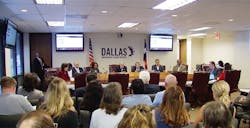Dallas district scales back plan that called for closing more than 20 schools
After community outrage over a proposal for possibly closing more than 20 schools, administrators in the Dallas Independent School District have dramatically scaled back their facilities plan.
The Dallas Morning News reports that the revised plan reduces the closings to two schools. But board members still would need to decide the fate of six other schools in the next few years.
The district is faced with aging school buildings as well as declining enrollment. In September, administrators put forth a proposal listing 22 schools as targets for closure. Families spoke out against the plan at board meetings and community discussions.
The updated plan just recommends moving the alternative programs at Nolan Estes Plaza and the Innovation, Design, Entrepreneurship Academy at James W. Fannin to other existing campuses and closing the sites where they now operate.
But six elementary schools would be "decision points" in the future because of their low enrollments: Ben Milam, John F. Peeler, James S. Hogg, Tom W. Field, William Brown Miller and Mark Twain.
It may be hard to justify keeping some of those schools open.
Field Elementary has 224 students and many are from transient families staying at a housing community from where they have to be bused to the campus because of busy roadways surrounding it. The nearby Jose "Joe" May Elementary that opened in 2016 could easily accommodate students in that area.
Some board members expressed frustration that they weren't given any warning before September's plan was revealed. And although the updated proposal may be easier for board members to accept, they noted that it was far from being something they were ready to adopt.
Reducing the proposed closures from 22 to a minimum of two would significantly cut how much the district would save. Annual savings would drop from $22.7 million to $2.2 million, and one-time revenue from selling properties would drop from about $45 million to about $11.5 million.
The revised facilities plan also calls for the board to seek its next bond election in 2021, which could provide funds for replacing 17 aging schools, down from 25 in the plan presented in September.
About the Author
Mike Kennedy
Senior Editor
Mike Kennedy, senior editor, has written for AS&U on a wide range of educational issues since 1999.
